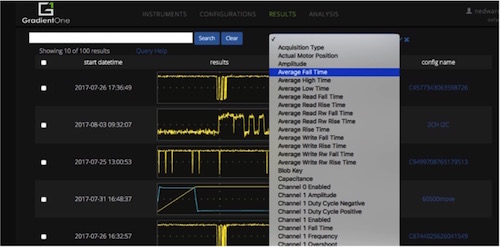
GradientOne’s Asset Utilization Service depicts the utilization of a test asset, including CPU information, percentage of utilization, and a pie chart breakdown of in use vs offline. Image Courtesy of GradientOne
Latest News
July 8, 2018
GradientOne is shaking up the somewhat stodgy automated testing market, bringing a taste of the cloud, Internet of Things (IoT), and big data analytics to make it easier for engineers to capture test data and generate insights throughout various phases in a product’s lifecycle.
“When it comes to hardware engineering, specifically the test engineering function, the way people have been doing things hasn’t changed much in decades,” explains Nick Edwards, CEO of GradientOne, which was founded in 2015. “We bring contemporary technology to the test workbench.”
GradientOne is a web-based Software-as-a-Service (SaaS) platform that lets engineers tap the power of a web browser and cloud computing to do hardware test automation, test data acquisition and archiving, and advanced data analytics, Edwards explains. There are a number of factors driving change for traditional test workflows throughout development lifecycle, Edwards says. For example, product development and compliance groups are dealing with increasingly complex products that demand more sophisticated testing and analysis while manufacturing needs end-to-end analysis across the entire lifecycle, and field support is under the gun to resolve customer problems through fast and easy access to test data and product records. Adding to the complexity is the increasing number of distributed R&D centers as well as the swelling ecosystem of contract manufacturers, he explains.
 Through its Google-like search interface, GradientOne lets users search test data in the cloud using metadata to filter results. Image Courtesy of GradientOne.
Through its Google-like search interface, GradientOne lets users search test data in the cloud using metadata to filter results. Image Courtesy of GradientOne.GradientOne’s cloud-based approach delivers on next-generation test engineering needs by providing a universally accessible system of record, which can be easily searched; near infinite storage and compute capacity; the ability to easily drill down and zoom out on specific data sets; and integrated advanced analysis and visualization capabilities. With the traditional test bench approach, the different disciplines often use different siloed tools to perform the testing applicable for their particular area—for example, compliance engineers do certification testing while manufacturing engineers perform diagnostics to break down problems—and none of the test data is easily shared and much of the labor is manual.
“All the stuff is typically done in varying degrees of manual labor and there is no one consistent way team to team, group to group, on how to get this stuff done,” Edwards explains.
GradientOne aims to streamline the process by allowing engineers to work within a browser environment to configure instruments and capture settings, and create test plan scripts without specialized programming. They can also maintain a single system of record for all test data, and users can search based off of any configuration parameter, measurement, or any other piece of metadata. “Every person in the custody chain has a different way of doing testing, but in the cloud, it’s a standard framework that spans the entire set of silos and functions,” he adds.
GradientOne doesn’t purport to be a replacement for well-entrenched testing workbenches like National Instruments’ LabView, he underscores. Rather, they see the platform as a complement to LabView for less complicated test scenarios, especially because it serves up a series of pre-packaged analytics to examine test results as opposed to requiring engineers to create them through visual programming on their own.
Beyond the core platform, GradientOne just released a new asset utilization service that helps companies with massive investments in testing equipment track and optimize their machinery. The asset utilization suite provides automated test asset discovery, utilization reporting, scheduling, and calibration tracking. Engineers can tap the platform to determine, for example, that a particular piece of test equipment was underused or that there was an anomaly to be fixed to avoid a product glitch and any resulting downtime.
“We’re trying to help companies optimize and enhance their test engineering operations and we do so by increasing the operational efficiency of how they’re doing tests and storing data,” Edwards says. “We’re also increasing the utilization of the millions of dollars in testing assets. Both move the bottom line of profitability.
For an overview of how GradientOne works, check out this video.
Subscribe to our FREE magazine, FREE email newsletters or both!
Latest News
About the Author
Beth Stackpole is a contributing editor to Digital Engineering. Send e-mail about this article to [email protected].
Follow DE





